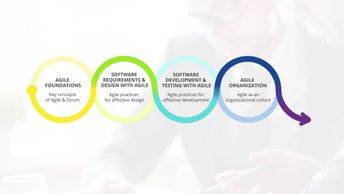Aspire Agile for Software Development Agile for Software Development Track 1: Agile Foundations
Final Exam: Agile Foundations will test your knowledge and application of the topics presented throughout the Agile Foundations track of the Aspire Agile for Software Development Journey.
| Objectives |
Final Exam: Agile Foundations - compare the Agile and Scrum frameworks and describe how they relate to each other
- describe the Agile software development methodology and recognize its benefits
- describe the Developer role and its responsibilities in a self-organizing Scrum team
- describe the Product Owner role and its responsibilities in a self-organizing Scrum team
- describe the Scrum backlog refinement meeting and recognize its importance to the sprint and its relationship to the product backlog
- describe the Scrum Master role and its responsibilities in a self-organizing Scrum team
- describe the Scrum planning meeting and recognize its importance to the sprint and its relationship to the sprint and product backlogs
- describe the Scrum sprint retrospective meeting and recognize its importance to the sprint and the team
- describe the Scrum sprint review meeting and recognize its importance to the sprint and its relationship to the sprint and product backlogs
- identify and describe Agile software development artifacts
- identify deliverables in the software development life cycle and recognize frequently used concepts and important terms in software development
- identify examples of situation that pose challenges to using Scrum
- identify key concepts related to the software testing process in software development
- identify the features of Scrum and recognize Scrum as the commonly adapted Agile approach
- identify the shortcomings of the Waterfall software development methodology
- identify the similarities in several traditional software development methodologies, including Waterfall
- identify the steps in the Agile life cycle
- recognize how the Agile methodology differs from traditional waterfall project management
- recognize roles and responsibilities on typical software development teams
- recognize the practice of continuous integration and continuous delivery (CI/CD) in software development and the Agile process
|


